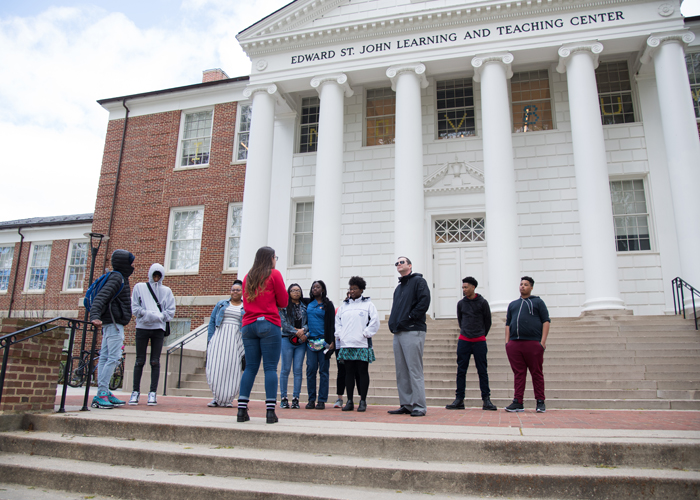CURE Scholars Encouraged To Find Their Niche
Stepping off the bus along Campus Drive, half a dozen ninth-grade CURE Scholars take in the sights of the University of Maryland, College Park (UMCP). The scholars have visited a number of other colleges this past year, but none quite like UMCP. With an undergraduate enrollment of more than 30,000 students in 2019, this is the largest campus they have ever set foot on.
“Tell me what you think of when you think about college,” Eden Garosi, UMCP's undergraduate admissions counseling and recruitment coordinator, asked the scholars.

The UMB CURE Scholars take a tour of the University of Maryland, College Park campus.
Tyler McKenzie from Green Street Academy raised his hand to answer. “At first, I thought college was all about studying and having fun like you see in the movies, but I talked to my teacher and he said that it’s not just about that. He said the most important part about college is to be yourself and to figure out who you are.”
That was the theme that carried through the rest of the group’s visit to UMCP on April 15: How do you find a sense of belonging at a large university?
(View a photo gallery.)
“What I want them to take away from this visit is that meeting lots of different groups and organizations can make a large school feel small. You can find your own niche within any community, and I think that’s very important,” explained Sequoia Wright, one of the program coordinators for CURE Connections (C2).
C2 is a continuation of the University of Maryland, Baltimore (UMB) CURE Scholars Program — a unique mentoring/STEM (science, technology, engineering, and math) education program aimed at reducing racial disparities in public health by establishing a pipeline to careers in STEM.
These ninth-graders became the CURE program’s first cohort of scholars four years ago and have now “graduated” to C2, which is specifically designed for ninth- and 10th-grade students. Part of that design is to get the scholars thinking about higher education early. As a result, UMCP is the fourth University System of Maryland (USM) school they have toured in the past year.
“I think that it’s important to start visiting schools in ninth grade because it helps them to see the seriousness of college,” explained Wright. “Once they have this better understanding of what a college expects and what the college atmosphere is like, they’ll be better prepared to stay focused in high school and to look towards a goal.”
Throughout the daylong visit to UMCP, the scholars were able to tour research labs in the chemistry building, take an abridged tour of the campus, learn about the application process, and meet two panels made up of current students pursuing careers in STEM. The UMCP students talked about their own college experiences and delved even deeper into the idea of finding a sense of belonging as students of color attending a mostly white institution.
“You start to notice you’re the only one who looks like you as the class sizes get smaller,” explained Simone Williams, a senior who is studying biology. “It does get hard sometimes, but I’m able to use that to empower myself to be stronger and persevere.”
She explained to the scholars that she found a sense of home and belonging by exploring different student organizations and Greek life.
“Sometimes it’s hard to find people I relate to, so that’s why I joined Alpha Kappa Alpha Sorority, Inc. (AKA), which is a historically black sorority,” Williams continued. “Joining AKA helped me find people I can really relate to, so you can get that HBCU [Historically Black Colleges and Universities] feel from a predominately white institution.”
The other panelists also talked about how they were able to find their place on campus by joining student groups. From intramural sports to social groups to academic clubs, there are more than 900 student organizations at UMCP. The CURE Scholars would have a buffet of options to sift through to find people they can relate to and, ultimately, find their own sense of self and belonging.
The scholars also learned about how college is different from high school. Garosi and the student panelists talked to the scholars about how they would have a lot more freedom to choose their schedules, their classes, and even their professors. The students on the panels talked very candidly about how they struggled to adjust to living on campus while balancing a social life, personal care, and academics during their first year of college.
“I remember my first semester I got a test back and I got a 65 percent,” said Angel Graham, a sophomore psychology major. “That’s the first time I ever got a D on anything! I had a mini-mental breakdown until I realized that the grading curve would bump it up to a B.”
The student panelists also emphasized to the scholars that there are plenty of resources on campus if they need help with grades or just need help feeling comfortable in a college setting.
“Don’t be afraid to be vocal about your struggles,” Graham told them. “If you’re having trouble do not stay quiet about it because it’s OK to need help. Find a professor or an advisor or even a friend and ask for help. No one will know you need it unless you ask.”
By the end of the day, the CURE Scholars had a much better understanding of what attending a larger university would be like and how to put personal touches on their college experience.
The scholars will continue their USM school tours in the summer with Loyola University Maryland for forensics training and the University of Maryland, Eastern Shore for a pharmacy bootcamp.



